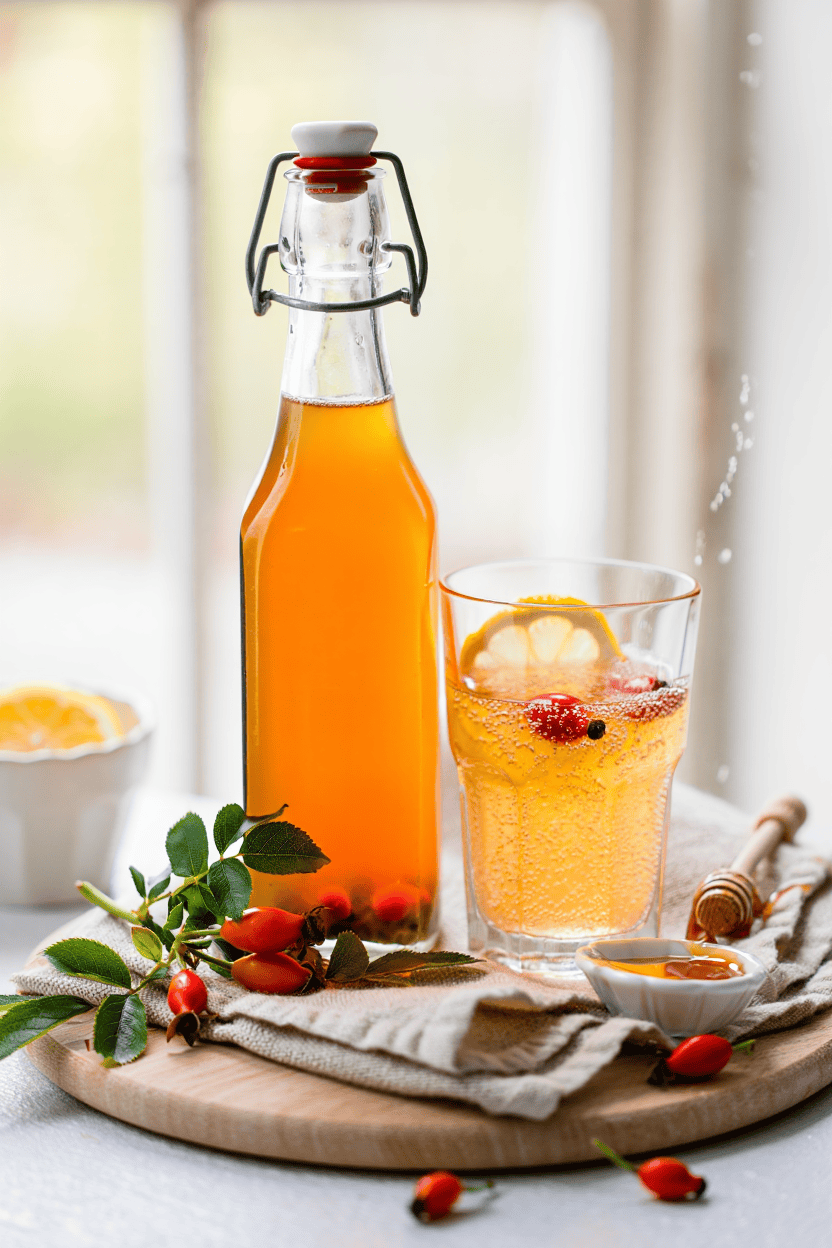Rosehip syrup couldn’t be easier to make—all you really need are fresh rose hips and a bit of honey or sugar. The result is a sweet-tart syrup that’s just as good drizzled over pancakes as it is swirled into tea or cocktails.

I love making a batch in the fall, not only because it tastes amazing, but also because it’s a great way to capture that fruity, tangy flavor of rose hips and save it for the colder months.
A lot of people keep rosehip syrup on hand during cold and flu season, since it’s been used for generations as a natural boost for the immune system. Technically, rose hips are packed with vitamin C, though most of it doesn’t stick around after cooking. For me, the real magic is in the flavor—it adds a cozy, slightly floral brightness to drinks and desserts that instantly feels like fall in a jar.
Why Rose Hip Syrup Belongs in Your Kitchen
There’s something special about rose hips—the way such a small fruit can hold so much goodness. Beyond their jewel-like color, they’re packed with nutrients: vitamin C, of course, but also vitamins A, D, and E, along with a whole family of antioxidants. Instead of thinking of rosehip syrup as “medicine,” I like to think of it as a cozy seasonal staple—one that quietly supports your body while brightening up everyday meals.
In fact, rosehip syrup has a long history as a cold-weather companion. Families once kept bottles on the shelf to help ward off winter colds, and the tradition continues for good reason. But even if you never reach for it as a remedy, it’s simply delicious—tangy, lightly sweet, and versatile enough to use in drinks, breakfasts, or desserts.
Choosing and Finding Rose Hips

Rose hips are the small fruits that form once roses finish blooming, and they’re one of the easiest wild foods to spot in the cooler months. By autumn, they ripen into bright red jewels, standing out against fading leaves, and often stay on the branches well into winter.
When it comes to making syrup, some hips are better than others. Rosa rugosa is famous for its large, fleshy hips, which are almost like tiny fruits on their own. They’re wonderful for jam or jelly, but a little too precious to boil down for syrup. Wild rose hips, by contrast, are smaller, seedier, and a bit fiddly to clean—but they’re perfect for infusions, teas, and syrups once strained.
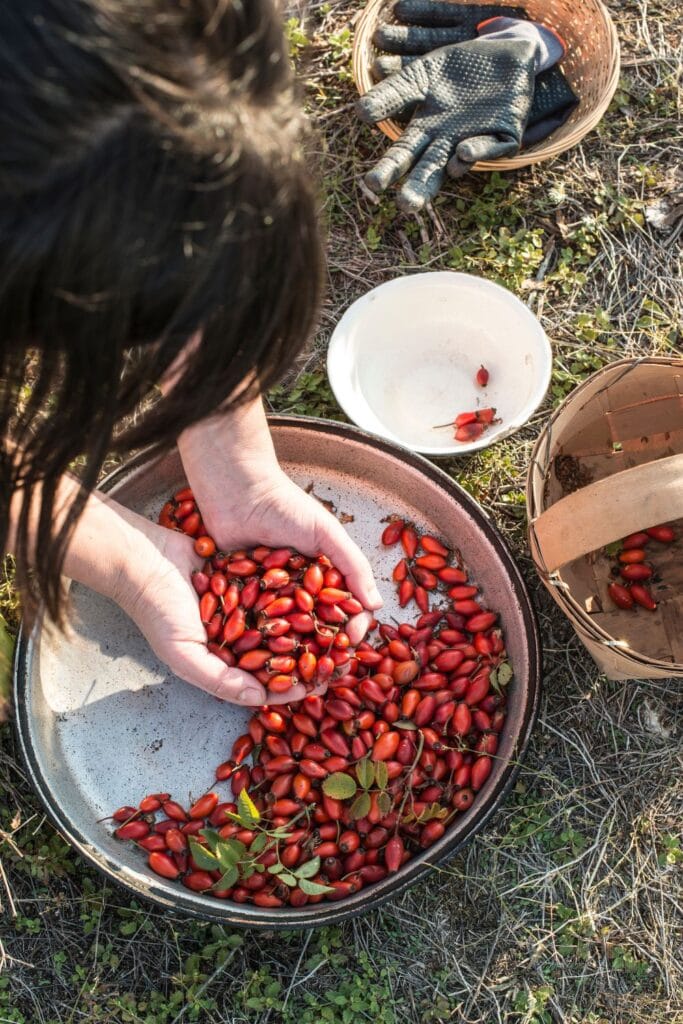
If you grow roses at home, you can simply stop deadheading and let the flowers set fruit. Foragers will find hips along hedgerows, woodland paths, or country roadsides—just be sure to pick from clean, unsprayed areas. And if fresh hips aren’t available, don’t worry. Dried rose hips are easy to find online or in herbal shops, and they produce a syrup with a slightly deeper, concentrated flavor that’s just as delicious as the fresh version.
Ingredients for Raw Honey Rosehip Syrup (30 servings)
- 8 cups fresh rose hips (or 4 cups dried rose hips)
- 6 cups water
- 3 cups raw honey (adjust to taste)
Optional flavor boosters:
- 4–5 thin slices of fresh ginger
- 2 strips of lemon or orange peel (or 2 teaspoons lemon juice added with the honey)
- 2 whole cinnamon sticks, 4–5 cloves, or 2 star anise pods
- 1 teaspoon pure vanilla extract (stirred in with the honey)
How to Make Rose Hip Syrup
1. Prepare the hips

Trim the blossom ends from about 8 cups of fresh rose hips (or 4 cups dried) and rinse well. Don’t worry about the seeds or fine hairs at this stage—they’ll be strained out later. If you’re using dried rose hips, you can skip rinsing.
2. Chop or break them down
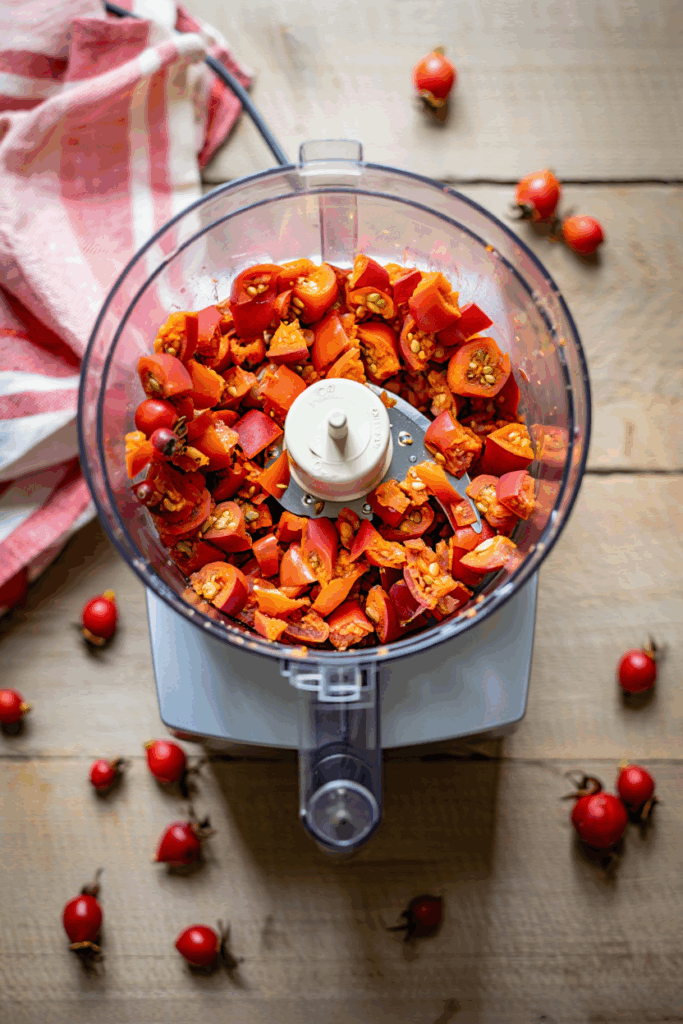
Slice the fresh hips into smaller pieces with a sharp knife, or pulse them a few times in a food processor.
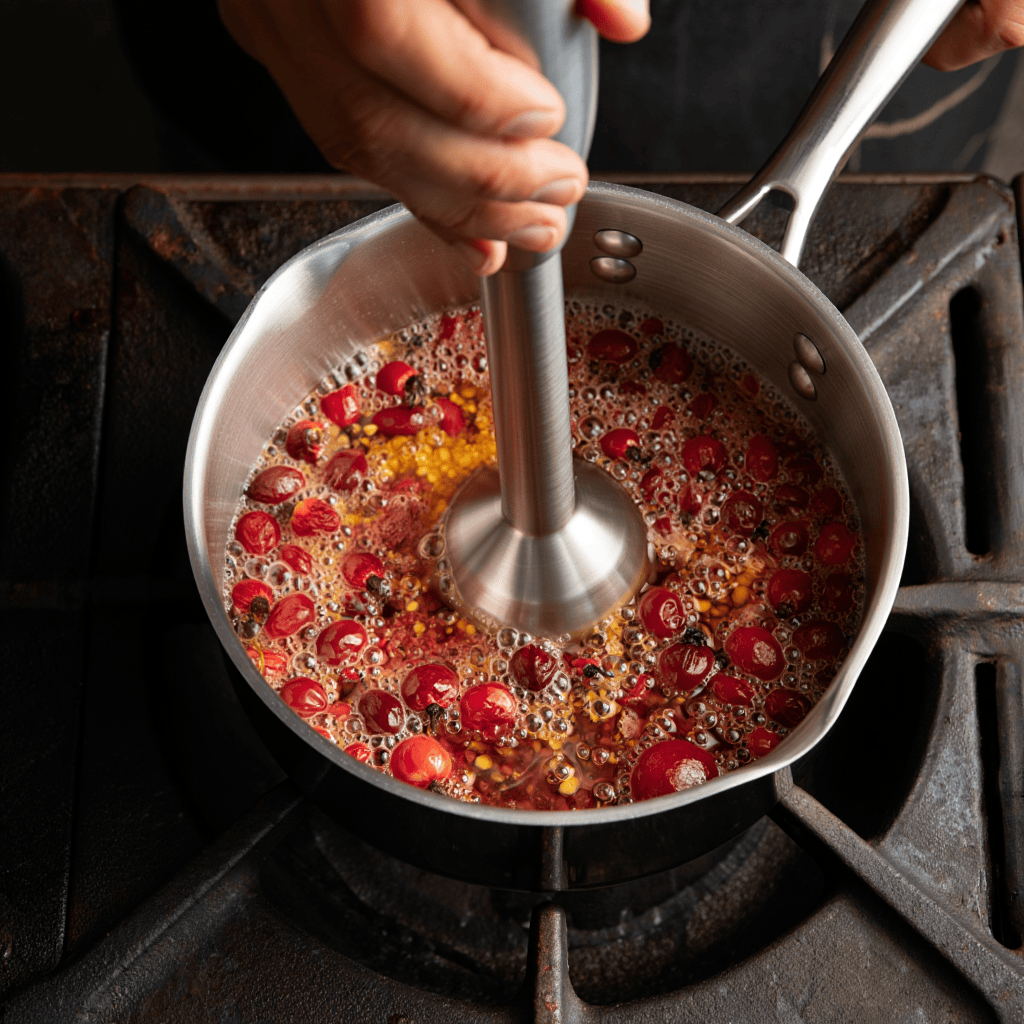
If using dried hips, let them soften in the simmering water, then use an immersion blender to break them down.
3. Simmer into a tea
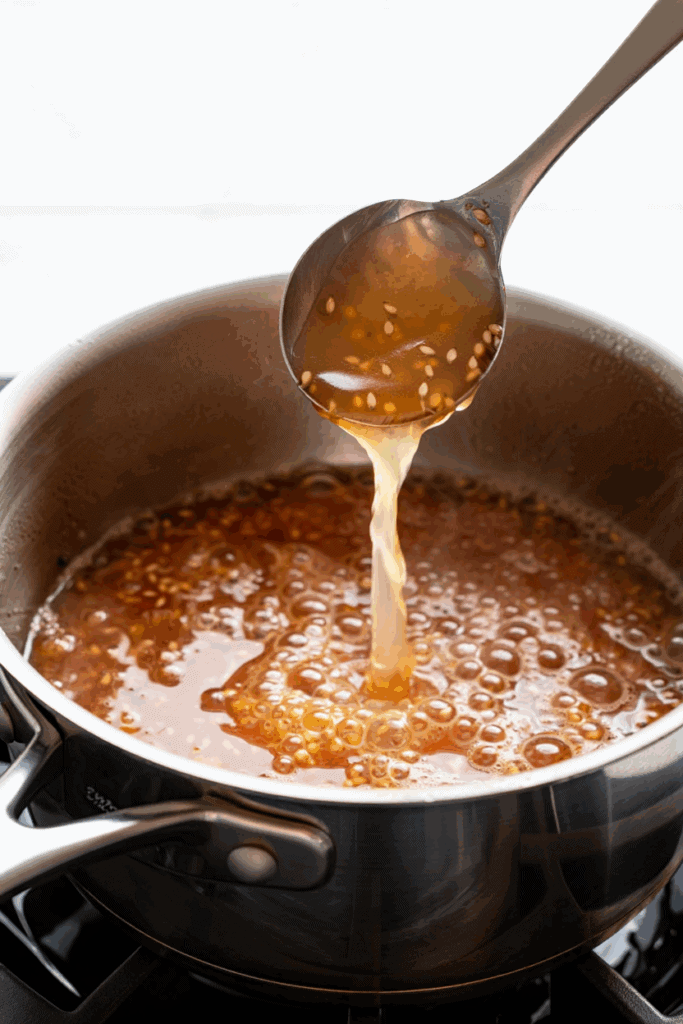
Add the rose hips to a large pot with 6 cups of water. Bring to a boil, then reduce to a gentle simmer. Let it cook for 20–25 minutes, or until the hips are soft and the liquid has reduced by about half. This creates a concentrated rosehip infusion.
4. Strain carefully

Pour the mixture through a fine mesh sieve lined with muslin or cheesecloth to remove the seeds and fine hairs. For the smoothest syrup, strain a second time.
5. Cool slightly before adding honey
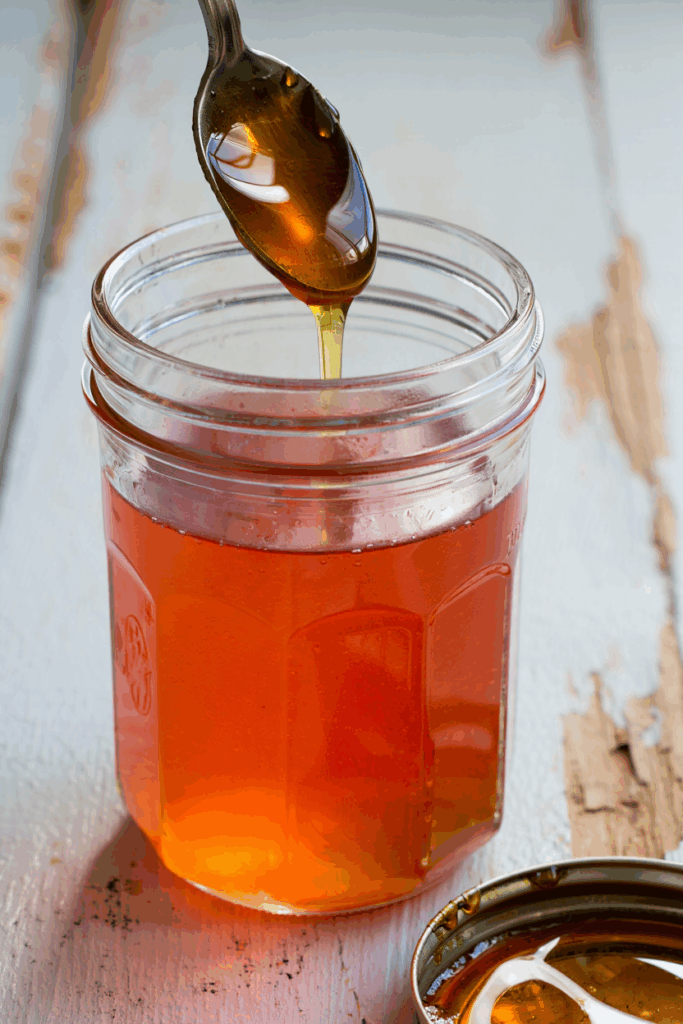
Allow the liquid to cool until it’s warm but not hot—around 110–120°F (43–49°C). This step is crucial for keeping the raw honey’s nutrients intact.
6. Stir in the raw honey
Mix in 3 cups of raw honey, adjusting the amount to taste. Stir until the honey is fully dissolved and the syrup is silky.
7. Bottle and store
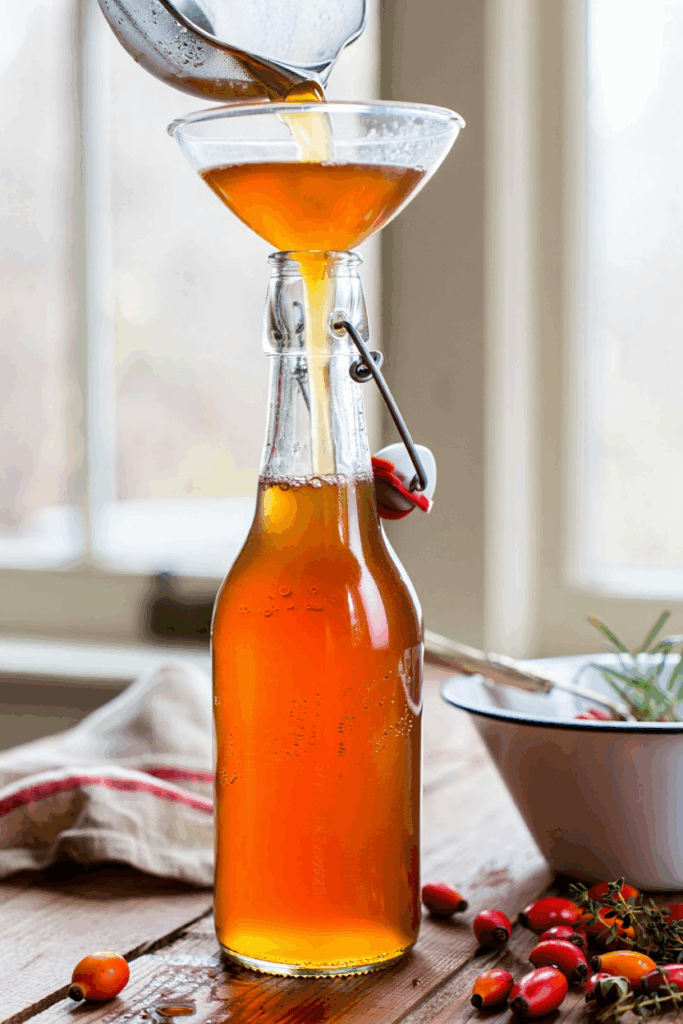
Pour the finished syrup into clean, sterilized bottles or jars. Keep refrigerated for up to 3–4 weeks, or freeze small portions (ice cube trays work perfectly) for longer storage.
Enjoying Rose Hip Syrup in the Kitchen
Rose hip syrup has a bright, tangy sweetness that pairs beautifully with both sweet and savory foods. A spoonful over hot pancakes or waffles turns breakfast into something special, while a drizzle over Greek yogurt or oatmeal gives a simple bowl a fruity lift. It’s also wonderful with desserts—think vanilla ice cream, cheesecake, or even tucked into the filling of a tart.

Beyond the table, this syrup is a natural mixer. Add a splash to sparkling water for a refreshing homemade soda, stir it into hot tea for a soothing evening drink, or experiment with cocktails for a seasonal twist. And if your syrup thickens a little in the fridge, that’s not a flaw—it simply spreads like a jelly, making it perfect for toast or scones.
Rose Hip Syrup for Wellness
For centuries, rose hips have been valued not just for their flavor but also for their nourishing qualities. They’re naturally rich in vitamins (especially C and A), antioxidants, and compounds that support overall vitality. When combined with raw honey—famed for its antibacterial and immune-supporting properties—the result is both delicious and restorative.
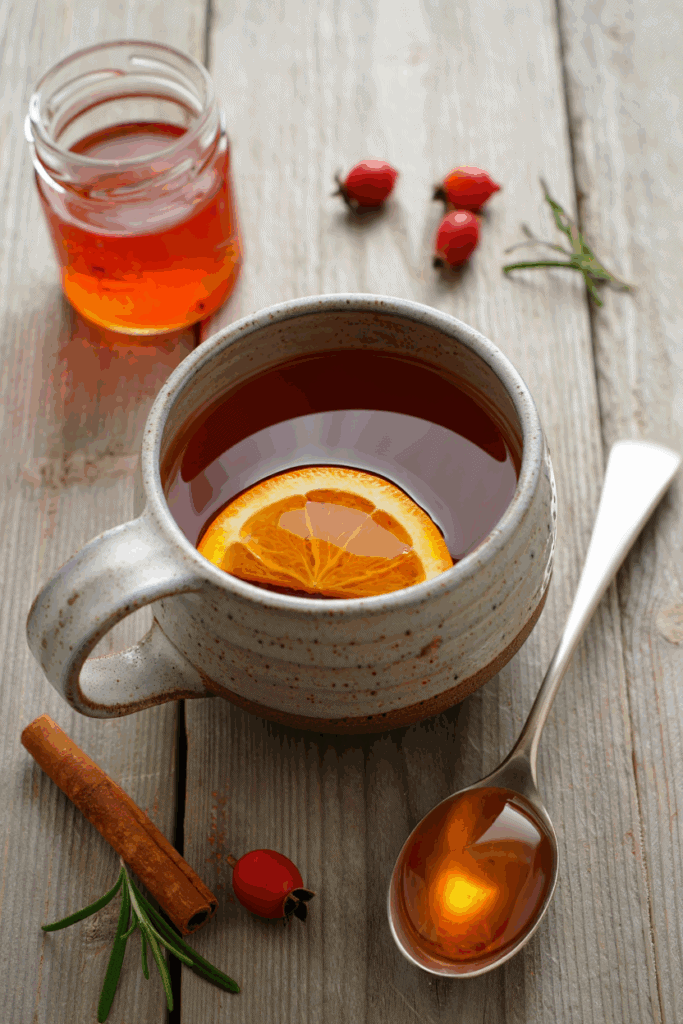
Many people keep rose hip syrup on hand during the colder months as a gentle home remedy. A tablespoon or two taken daily can be a comforting ritual, and at the first signs of a cold, slightly larger amounts may help soothe the body. While research continues into the full range of benefits, there’s no denying the syrup feels like bottled sunshine during winter’s darker days.
Rose Hip Syrup for Children
Rose hip syrup is a safe and nourishing choice for children over the age of one year. For little ones ages 1–5, a good dose is 1–2 teaspoons twice daily, with amounts increasing gradually as they grow.
Important: Infants under 12 months should never be given rose hip syrup (or any remedy with raw honey) because of the risk of botulism.
Honey Rosehip Syrup from Foraged Rose Hips
Ingredients
- fresh rose hips (or 4 cups dried) 8 cups
- water 6 cups
- raw honey (adjust to taste) 3 cups
- –5 slices fresh ginger 4
- strips lemon or orange peel (or 2 tsp lemon juice) 2
- cinnamon sticks (4 cloves, or 2 star anise pods) 2
- pure vanilla extract (stirred in with honey) 1 tsp
Instructions
- Wash fresh rose hips, trim stems and blossom ends, and cut into halves or quarters. Discard damaged hips. If using dried hips, lightly crush them with a mortar and pestle or food processor.
- Add rose hips and 6 cups of water to a large saucepan. Bring to a boil, then reduce to a gentle simmer for 20–25 minutes, until softened and liquid has reduced by about half. If using whole hips, mash them gently once softened.
- Strain the mixture through a cheesecloth-lined sieve into a bowl. Press the pulp to release liquid, then gather the cloth and squeeze out any remaining juice. Strain twice for smoothness.
- Let the strained liquid cool until warm but not hot (about 110–120°F / 43–49°C).
- Stir in 3 cups raw honey, adjusting to taste, until fully dissolved. Add vanilla extract here if using.
- Pour the syrup into sterilized bottles or jars. Store in the refrigerator for 3–4 weeks, or freeze in small portions for longer storage.
Notes
- Honey vs. Sugar: Unlike sugar syrups, raw honey is added after cooling to preserve enzymes and nutrients.
- Flavor Twists: Try ginger for warmth, citrus peel for brightness, or cinnamon and cloves for a festive, spiced version.
- For Kids: Safe for children over 1 year old (never give honey to infants under 12 months).
- Storage Tip: Freeze in ice cube trays for easy single-serve portions.

